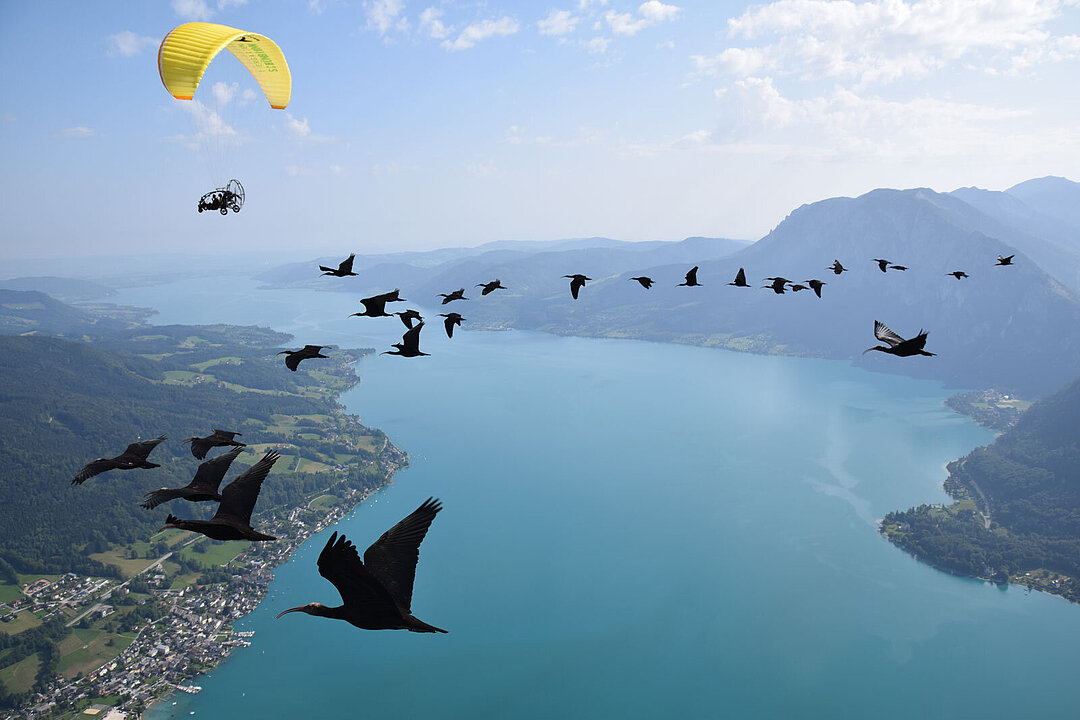
Despite its predominantly warm temperate climate zone, Europe has a wide variety of habitats. The main issues for conservationists in the region are habitat destruction and fragmentation, a lack of conservation corridors, pollution and poaching.
Northern bald ibis reintroduced to its natural habitat in the Alps
Hellabrunn Zoo supports the Waldrappteam, a conservation project that is committed to reintroducing the northern bald ibis (in German known as “Waldrapp”), one of the world's most endangered bird species, to the Alps. The project is among the largest conservation efforts in Europe, and has yielded successful results. The aim of the project is to establish self-sufficient migratory colonies in Alpine regions.


A long-lost friend
Up until the 17th century, the northern bald ibis was a familiar bird in Central Europe, especially in the Alps. Sadly, the chicks were considered a delicacy and were hunted so intensively that the species was completely wiped out in Central Europe. In fact, there was a long period when, with the exception of a few groups in human care, the only surviving colonies were a sedentary population in Morocco and a small migratory population in the Middle East. Since its launch in 2002, the Waldrappteam has been working to establish a habitat in Europe for the migratory bird. The European Union recognises the importance of this project and supports it financially under the LIFE+ funding programme.
How is a migratory population established?
Some migratory birds, such as the northern bald ibis, learn the route to their wintering grounds by flying with their parents on their first journey. A simple reintroduction of the species to the region is therefore not enough to establish a self-sufficient population. The reintroduced northern bald ibis needs to be taught the migratory routes to their winter quarters. It works like this:
- Chicks hatched in zoos are reared by hand, with a human foster parent assigned upon hatching.
- As soon as the young birds are able to fly, they are trained to follow the project’s microlight aircraft along a migration route.
- When the human foster parent flies south in the microlight aircraft in the autumn, the young birds will follow and thus learn the migration route to their wintering ground.
- Upon reaching sexual maturity, they return to their breeding grounds via the migration route they have learned.
- At the beginning of the following autumn, these trained birds will then fly unassisted with their young to the wintering grounds.

Achievements
In 2007, the Waldrappteam made its first successful flight with northern bald ibises over the Alps to Italy using a microlight aircraft. Four years later the birds began returning unassisted to the starting point in Burghausen, Germany. It took a few more years for a self-sufficient breeding colony to be established, the first in Europe for 400 years. A huge success for the project and the birds. There are now plans to establish further self-sufficient migratory colonies in the Alps. The new project regions are in Überlingen, Rosegg, Goldau, Bussolengo and Kuchl.
In addition to its reintroduction efforts, the Waldrappteam is trying to curb illegal hunting of the birds by monitoring individual birds with GPS trackers. They work with Italian hunting associations to raising awareness for this equally important cause.
Landscape conservation in Munich
The LBV Munich (Bavarian Society for the Protection of Birds and Nature) is committed to the conservation of species and biotopes in the greater Munich area. The society is not only involved in in-situ conservation, but also aims to arouse enthusiasm for conservation through environmental education. Hellabrunn Zoo regularly offers financial support to the LBV Munich to protect the Allacher Heide heathland.


Biodiversity conservation on the outskirts of the city
An important biodiversity hotspot is located right here in Munich! The Allacher Heide is a beautiful heathland situated near the München Nord Rangierbahnhof (Munich North marshalling yard). Now a relatively small remnant of what was once a much larger heath complex in north Munich, it offers a protected habitat for typical Munich heath species. The LBV has been maintaining the open landscape since 2004, with the help of many local volunteers, according to a concept that meets the needs of the local flora and fauna.
How can we protect the heathland?
This is not an easy question to answer. If left undisturbed, the heathland would revert to woodland over time. Centuries ago, large grazers such as aurochs and bison kept the heathland free of overgrowth. Later hardy livestock such as sheep and goats took over the role. Today, this job is done by the LBV. Having the right mix of landscape maintenance and "let it grow wild" is important. Hence, certain areas are mowed to avoid a litter layer (dead grass and flowers that prevents new plants from growing). Invasive species, such as Turkish rocket (Buniasorientalis), which competes with many native species, are also removed from the ecosystem in this way.
Rare species
The heathland is regularly mapped by experts, which means that every square metre is examined every 2-3 years for species occurrence. This allows the LBV to determine whether the maintenance measures are beneficial and whether there are still areas that need attention. The Allacher Heide is home to variety of rare species, such as the blue-winged grasshopper (Oedipoda caerulescens), which is highly endangered in Bavaria, but regularly found on the heath. The Idas blue (Plebejus idas), a regionally endangered butterfly, also occurs here. The Allacher Heide also has a large number of clover species and ants, which are essential to the survival of the butterflies.


